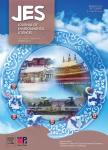Investigating the impact of Glyoxal retrieval from MAX-DOAS observations during haze and non-haze conditions in Beijing
Investigating the impact of Glyoxal retrieval from MAX-DOAS observations during haze and non-haze conditions in Beijing作者机构:School of Earth and Space Sciences University of Science and Technology of China Center for Excellence in Regional Atmospheric Environment Institute of Urban Environment Chinese Academy of Sciences Key Lab of Environmental Optics & Technology Anhui Institute of Optics and Fine Mechanics Chinese Academy of Sciences Anhui Province Key Laboratory of Polar Environment and Global ChangeUSTC Institute of Environmental Sciences and Engineering National University of Sciences and Technology
出 版 物:《Journal of Environmental Sciences》 (环境科学学报(英文版))
年 卷 期:2019年第31卷第6期
页 面:296-305页
核心收录:
学科分类:0830[工学-环境科学与工程(可授工学、理学、农学学位)] 07[理学] 070602[理学-大气物理学与大气环境] 0706[理学-大气科学]
基 金:supported by grants from the National Key Research and Development Program of China (Nos. 2018YFC0213104) National Natural Science Foundation of China (Nos. 41722501, 91544212, 51778596, 41575021) National Key Research and Development Program of China (Nos. 2016YFC0203302)
主 题:Glyoxal DOAS Retrieval settings Photolysis Haze days
摘 要:This study presents the Multi Axis Differential Optical Absorption Spectroscopy(MAXDOAS) measurements for Glyoxal(CHOCHO) in Beijing, China(39.95°N, 116.32°E). CHOCHO is the smallest compound of di-carbonyl group. As a primary sink of CHOCHO, its photolysis with NOx(oxides of nitrogen) results in the production of tropospheric ozone. Therefore,the focus of CHOCHO DOAS measurements is increasing in trend. We did the measurements from 09 May 2017 to 09 September 2017. The study was conducted to compare different retrieval settings in order to reveal best DOAS fit settings for CHOCHO;furthermore, effect of haze and non-haze days on CHOCHO concentration was examined.The root mean square of residual and Differential Slant Column density(dSCD) error was reduced when measurements were done with lower wavelength limit around 432–438 nm and upper intervals around 455–460 nm. Thus, lower wavelength intervals around432–438 nm and upper intervals around 457–460 nm were best for the retrieval of dSCDs for CHOCHO. Meteorological conditions like haze or non-haze days did not have significant effect on DOAS fit parameters. The CHOCHO vertical column densities range from 1.33 E +14 to 9.77 E + 14 molecules/cm2 during the study period with average of 6.16 E +14 molecules/cm2. The results indicated that during haze days CHOCHO concentration was higher because of lower rate of photolysis and atmospheric oxidation potential. Our results did not show any significant weekend effect on CHOCHO atmospheric concentration.



